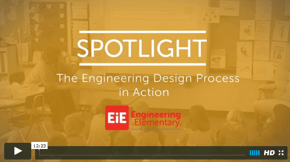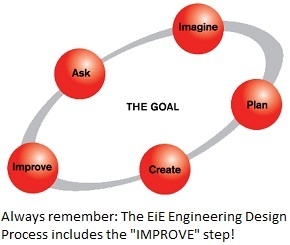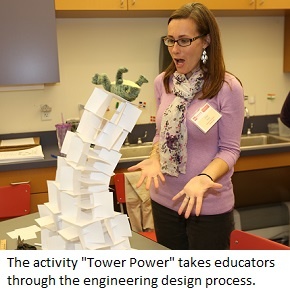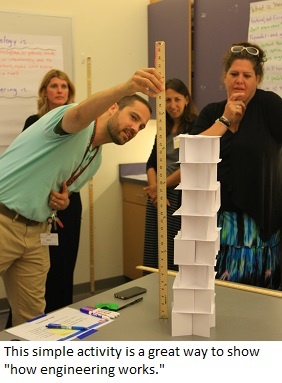 Maybe you’re teaching EiE for the first time this semester. Or maybe you already use the curriculum in your elementary classroom but want to brush up on your knowledge. Either way, EiE Spotlight Videos are a great way to refresh and expand your understanding of the EiE curriculum.
Maybe you’re teaching EiE for the first time this semester. Or maybe you already use the curriculum in your elementary classroom but want to brush up on your knowledge. Either way, EiE Spotlight Videos are a great way to refresh and expand your understanding of the EiE curriculum.
Watch this Spotlight Video, “The Engineering Design Process in Action,” to learn about the age-appropriate, five-step Engineering Design Process that’s at the heart of every curriculum unit.Engineering in Five Easy Steps
The term “Engineering Design Process” may sound technical. But when you break it down, step by step, you’ll discover this practical approach to problem solving is easy to understand and to master—and students can apply it in many ways, not just for engineering.
The EiE Engineering Design Process consists of five steps:
 ASK
ASK- IMAGINE
- PLAN
- CREATE
- IMPROVE
Although we talk about “THE” Engineering Design Process, it’s not a monolithic concept. There are many different engineering design processes. Working engineers may use an EDP with more than five steps.
We created a five-step process because, early in our curriculum development work, elementary teachers told us that five is a magic number for kids. They like to count on their fingers and can easily remember “one hand’s worth” of items!
The Engineering Design Process in Action
 To help educators improve their understanding of the Engineering Design Process, we use an exercise called “Tower Power” in our professional development workshops. The activity is concise—it takes you through all five steps in less than an hour.
To help educators improve their understanding of the Engineering Design Process, we use an exercise called “Tower Power” in our professional development workshops. The activity is concise—it takes you through all five steps in less than an hour.
The challenge is to design and build a tower, using index cards. Here’s how it connects to the five steps:
- ASK: What problem is each team is trying to solve? The tower must be tall enough to display a “statue” (a small stuffed animal) at eye level. It must be sturdy enough to support the “statue” without collapsing immediately!
- IMAGINE: What are some solutions? As educators brainstorm, they quickly discover there are many different ways to fold, roll, and stack index cards.
- PLAN: It’s tempting to just start building. But Tower Power calls for participants to draw up a plan. There are limits to how many cards and how much tape they can use!
- CREATE: Teammates work together to build and test their towers.
- IMPROVE: In every workshop, some towers stand tall and strong, and others fail magnificently. We always budget time for participants to learn from experience and try to improve their designs.
Everyone Can Engineer!
 When educators work their way through the five steps of the Engineering Design Process, we see the magic happen over and over.
When educators work their way through the five steps of the Engineering Design Process, we see the magic happen over and over.
Smiles blossom as everyone realizes that engineering is not some mysterious, highly technical practice that only math geniuses and science geeks dare to attempt; it’s a straightforward and highly engaging process that anyone can embrace and apply. As the title of the workshop proclaims, Everyone Engineers!
MORE RESOURCES
- Download the Tower Power activity
- Watch educators build towers in this Video
- Browse all EiE Spotlight Videos
- Rock out! Listen to the EiE EDP Song!
Engineering is Elementary is a project of the National Center for Technological Literacy at the Museum of Science, Boston.








